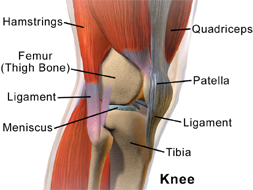|
Muscle Balancing:
Criterion-Based Evaluation and
Treatment of the Knee
Complex |
 Muscle
Balancing (MB) is an easily applied manual therapy
approach that reduces protective muscle spasm in as little
as 90 seconds causing an immediate improvement in pain-free
range of motion and function. MB techniques
gently treat protective muscle spasm by inhibiting muscle
spindle activation, thereby decreasing afferent impulses to
the brain. By interrupting this pathway, the muscle resumes
a normal resting tone thus relieving muscle tenderness,
protective muscle spasm, fascial tension, joint
hypomobility, and pain.
Muscle
Balancing (MB) is an easily applied manual therapy
approach that reduces protective muscle spasm in as little
as 90 seconds causing an immediate improvement in pain-free
range of motion and function. MB techniques
gently treat protective muscle spasm by inhibiting muscle
spindle activation, thereby decreasing afferent impulses to
the brain. By interrupting this pathway, the muscle resumes
a normal resting tone thus relieving muscle tenderness,
protective muscle spasm, fascial tension, joint
hypomobility, and pain.
In the clinic, physical therapists commonly see patients who
present with protective muscle spasm due to injury and
trauma. Since MB is not only effective, but
also efficient at treating protective muscle spasm, every
physical therapist should consider utilizing this treatment
approach to improve pain-free range of motion and function
in those patients. MB is very easy to
perform and can be successfully incorporated into any
treatment session by using the following information from
the criterion-based assessment provided in the sample case
below.
During the initial visit, all manual therapists face the
same question, where do I treat? Do I treat locally at the
site of pain or treat holistically to address global
dysfunctions and lesions that may be impairing the pathway
for healing? Then, once we decide where to treat, we need to
decide which manual therapy treatment approach to use.
However, before you can decide which manual therapy
treatment approach to use, including MB,
you need to have a clear understanding of the source of the
pain and dysfunction. Is the patient complaint coming from a
muscle, joint, fascial, lymphatic, or energetic/emotional
impairment? This is important because treating with an
inappropriate treatment approach and manual therapy
technique in an inappropriate area is not only inefficient
for our patients, but could also be potentially harmful.
Without some type of criteria, how can we as clinicians
discern what the patient needs? To do that, each visit
should begin and end with an assessment.
The preferred treatment approach begins with a patient
history and a Total Body Screening Examination
(TBSE) to determine if extraneous lines of tension
and dysfunctions throughout the body may be influencing the
local area of complaint. Some common areas are lines of
tension found in the transverse diaphragms which, if
restricted, can affect the vertical flow of vital
structures, including the arterial, venous, lymphatic,
nervous, and energetic flow necessary for healing.
Additionally, dysfunctions of the autonomic nervous system,
which controls vasomotion of the blood vessels, can affect
the pathways of healing for all bodily tissues. If lines of
extraneous lines of tension and total body dysfunctions are
found to be influencing the area of complaint, then
treatment must be performed globally prior to local
treatment.
For example, if a patient complains of right knee pain and
dysfunction, we must consider that there may be extraneous
lines of tension in the transverse diaphragms and/or
dysfunction of the autonomic nervous that could affect the
pathway of healing for that knee. Before treating locally at
the knee, we need to consider what the structures of the
knee need to heal. First, the knee will need an unobstructed
supply of oxygenated and nutrient rich blood, balanced
nervous input, and energy. Second, the knee will also need
an unimpaired venous, lymphatic and energy drainage pathway
removing deoxygenated blood and waste products. However,
there is an old saying in osteopathy that for this to occur,
drainage must precede supply. This means that for oxygen and
nutrients to reach the knee to help it heal, we need to
remove the metabolic waste product first. Since extraneous
lines of tension and autonomic dysfunction affect the
vertical flow of vital structures and pathways of healing
for all bodily tissues, including the knee, these must be
evaluated and addressed prior to local treatment.
However, if the TBSE determines that there
are no extraneous lines of tension and autonomic
dysfunction, then a local evaluation can be performed.
Continuing with example of right knee pain, local evaluation
consists of ARTS:
• (A)symmetry: Evaluate the postural
alignment of the knee for asymmetry.
• (R)ange of Motion: Evaluate the active
and passive range of motion (AROM/PROM) of the knee. Assess
for restrictions and the end feel. Soft/boggy end feel
indicates swelling, hard end feel indicates joint
dysfunction, and firm end feel indicates muscle spasm or
fascial tension.
• (T)ension Tests: Evaluate for tension in
the knee looking for a soft, supple, and springy end-feel. A
hard and restrictive end-feel indicates a joint lesion.
• (T)issue Tenderness: Evaluate for
tenderness in the muscles of the knee. Increased tenderness
such as an 8-10/10 can indicate protective muscle spasm.
• (T)issue Texture Changes: Evaluate for
tissue texture changes in the knee, which indicate swelling.
• (S)pecial Tests: Evaluate using specific
orthopedic (including fascial glide) and dynamic tests to
confirm findings.
If the primary lesion found on the Local Evaluation
(ARTS) contributing to the complaint of right knee
pain and dysfunction is identified by a positive Tissue
Tenderness Test (8-10/10), then MB is
indicated for this case. Other findings supporting the use
of MB are asymmetry in the knee and
decreased knee range of motion with a firm end feel. If
there is more than one muscle involved, and there typically
is, you will need to determine and prioritize the muscle
with the greatest tenderness.
The MB procedure involves placing the
involved body part in a position of comfort for
approximately 90 seconds to reduce and arrest inappropriate
proprioceptor activity in the muscle. With the knee, if the
patient has protective muscle spasm in the quadriceps, the
muscle must be shortened into a position of comfort until
the tenderness and pain decreases or disappears. Once
reached, the patient is then held in this position for at
least 90 seconds before passively returning to a neutral
position. The tender point is reassessed to determine
further treatment. If successful, then treatment continues
with all additional points until none are found on further
evaluation. However, if the priority tender point is treated
first, as previously stated, then no additional treatment
may be needed. After treatment, there will be an immediate
decrease in tenderness and pain in the treated muscle
allowing for an increase in functional level. As a result,
MB alleviates both soft tissue and
articular dysfunctions in the body, thus restoring proper
pain-free movement.
When indicated on a criterion-based evaluation, the
MB treatment approach helps reduce muscle
tenderness, protective muscle spasm, fascial tension, and
pain. Accordingly, MB increases joint
mobility, decreases swelling, restores proper joint
biomechanics, improved functional ROM, and normalizes
postural alignment. Clinically, patients will see an
immediate decrease in complaints of pain and an increase in
functional level. MB can effectively treat
patients with orthopedic pain, orthopedic dysfunctions, and
postural deformities resulting from protective muscle spasm.
Because of the gentleness and effectiveness of MB,
it is appropriate for the following patient populations:
pediatrics, geriatrics, athletes, trauma patients, general
orthopedic patients, amputees, respiratory compromised, and
neurological patients.
Muscle Balancing is part of the extensive
manual therapy curriculum offered at the D’Ambrogio
Institute (DAI). MB courses include
instruction in a criterion-based Local Treatment Approach to
evaluate and treat protective muscle spasm found in the
muscles of the Upper Quadrant (cranium, cervical spine,
thorax, and upper extremity) and Lower Quadrant (lumbar
spine, pelvis, and lower extremity). Please feel free to
visit
www.DAmbrogioInstitute.com for more information.
Last revised: November 20, 2019
by Kerry D’Ambrogio DOM, AP, PT, DO-MTP and Trisha Becker, PT, DPT, MHS, OCS
 Kerry
D’Ambrogio is a physical therapist, osteopath and
board-certified acupuncture physician. He is the president
and director of the D’Ambrogio Institute and Therapeutic
Systems, Inc., in Sarasota, Fla. He is the co-author of
Positional Release Therapy (Mosby). D’Ambrogio is a
graduate of the physical therapy program at the University
of Toronto (Canada), the osteopathic program at the Canadian
Academy of Osteopathy (Hamilton, Ont.), the John Wernham
College of Classical Osteopathy (Maidstone, England), and
the acupuncture program at the Academy of Chinese Healing
Arts (Sarasota, Fla.).
Kerry
D’Ambrogio is a physical therapist, osteopath and
board-certified acupuncture physician. He is the president
and director of the D’Ambrogio Institute and Therapeutic
Systems, Inc., in Sarasota, Fla. He is the co-author of
Positional Release Therapy (Mosby). D’Ambrogio is a
graduate of the physical therapy program at the University
of Toronto (Canada), the osteopathic program at the Canadian
Academy of Osteopathy (Hamilton, Ont.), the John Wernham
College of Classical Osteopathy (Maidstone, England), and
the acupuncture program at the Academy of Chinese Healing
Arts (Sarasota, Fla.).
 Muscle
Balancing (MB) is an easily applied manual therapy
approach that reduces protective muscle spasm in as little
as 90 seconds causing an immediate improvement in pain-free
range of motion and function. MB techniques
gently treat protective muscle spasm by inhibiting muscle
spindle activation, thereby decreasing afferent impulses to
the brain. By interrupting this pathway, the muscle resumes
a normal resting tone thus relieving muscle tenderness,
protective muscle spasm, fascial tension, joint
hypomobility, and pain.
Muscle
Balancing (MB) is an easily applied manual therapy
approach that reduces protective muscle spasm in as little
as 90 seconds causing an immediate improvement in pain-free
range of motion and function. MB techniques
gently treat protective muscle spasm by inhibiting muscle
spindle activation, thereby decreasing afferent impulses to
the brain. By interrupting this pathway, the muscle resumes
a normal resting tone thus relieving muscle tenderness,
protective muscle spasm, fascial tension, joint
hypomobility, and pain.



